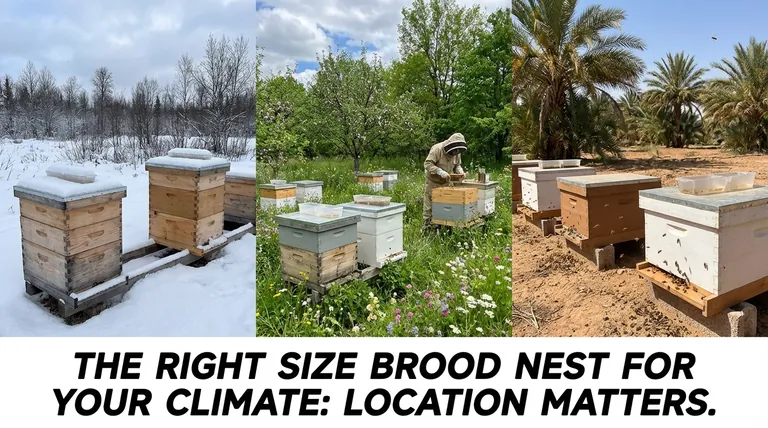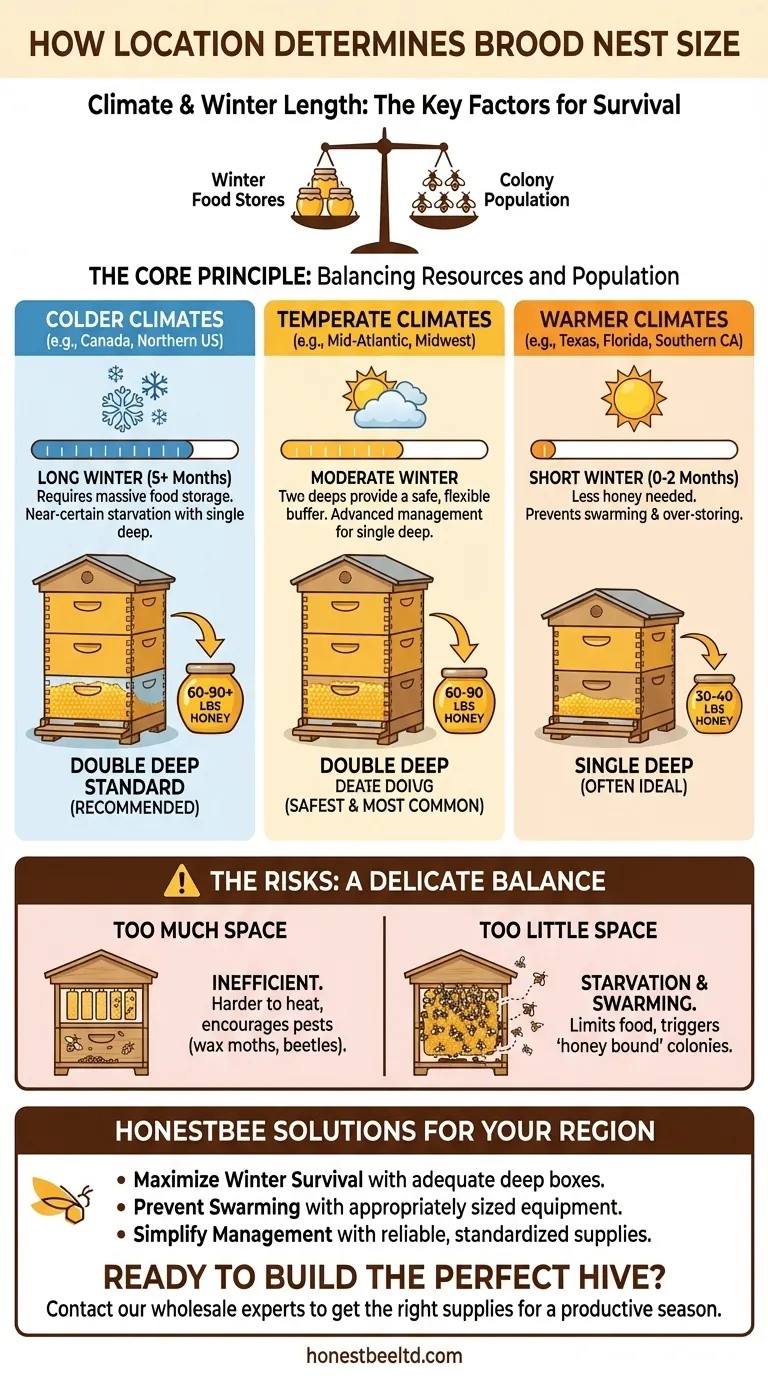Yes, location is one of the most critical factors in determining the correct size for a honey bee brood nest. Beekeepers in colder regions with long winters, like Canada, require significantly more space for winter food stores than beekeepers in warmer climates like Texas, where foraging seasons are longer and winters are mild. This difference is fundamental to colony survival.
The size of your brood nest is not just a preference; it is a direct response to your local climate. The primary goal is to provide enough space for the colony to store the precise amount of honey and pollen needed to survive the non-foraging period, whether that is a long, cold winter or a short, mild one.
The Core Principle: Balancing Resources and Population
The brood nest, or brood chamber, is the heart of the colony. It serves two vital functions: it's the nursery where the queen lays eggs and new bees are raised, and it's the pantry where the bees store the honey and pollen they need to survive.
Why Winter Length Governs Everything
The single most important variable is the length of your winter. A colony in a northern climate may be confined to the hive for six months or more, unable to forage for new resources.
To survive this period, the bees must have a massive stockpile of honey. This requires a larger brood chamber—typically two, or sometimes even three, deep hive bodies—to serve as a pantry.
The Impact on Colony Population
In a colder climate, the colony needs a very large population going into winter to generate enough heat to keep the cluster warm. A larger brood chamber allows the queen to lay more eggs in late summer, building this robust winter population.
In a warmer climate, the winter break is short or non-existent. The colony needs far less honey to survive, so a smaller brood chamber is sufficient.
Climate-Based Brood Nest Configurations
While every microclimate is unique, we can establish reliable guidelines based on broad regional climates. These configurations are based on standard 10-frame Langstroth equipment.
Colder Climates: The Double Deep Standard
For regions with long, cold winters (e.g., Canada, New England, the Upper Midwest), a two-deep brood chamber is the standard and recommended setup.
This configuration provides ample space for the queen to lay in the bottom box during the summer, while the bees backfill the top box with the 60-90 pounds of honey they need to survive winter. Using a single deep in these areas is a near-certain death sentence from starvation.
Temperate Climates: The Flexible Zone
In more moderate climates with distinct but less severe winters (e.g., the Mid-Atlantic, parts of the Midwest), a two-deep brood chamber remains the safest and most common choice.
However, some experienced beekeepers in these zones successfully manage single-deep brood chambers. This requires intensive management to prevent swarming and ensure adequate feeding, making it an advanced technique.
Warmer Climates: The Case for a Single Deep
For beekeepers in subtropical or southern regions with very short, mild winters (e.g., Florida, Southern California, Texas), a single-deep brood chamber is often ideal.
A shorter winter means the colony only needs 30-40 pounds of honey. A single deep provides enough space for this and prevents a common problem where bees fill a second box with honey, restricting the queen's laying space and encouraging swarming.
Understanding the Trade-offs
Choosing a brood nest size involves balancing risks. There is no single "perfect" size, only the right size for a specific goal and location.
The Risk of Too Much Space
Providing a colony with excessive, unused space is inefficient. The bees must expend extra energy to patrol and defend this area from pests like wax moths and small hive beetles.
It can also make it harder for the colony to thermoregulate the core nest area, potentially slowing brood production in the spring.
The Risk of Too Little Space
This is the more dangerous of the two errors. A brood nest that is too small presents two critical threats.
First, it limits the amount of honey the bees can store, creating a high risk of starvation during the winter. Second, in the spring and summer, the queen can quickly run out of cells to lay eggs in, a condition known as being "honey bound." This is a primary trigger for swarming, where you can lose half your bees.
Determining the Right Size for Your Apiary
Your first step should always be to connect with local beekeeping associations. Their regional expertise is invaluable. Based on the principles discussed, however, you can confidently make a starting choice.
- If your primary focus is winter survival in a cold climate (5+ months of winter): Begin with a two-deep brood chamber. This is non-negotiable for ensuring adequate food stores.
- If your primary focus is simplified management in a warm climate (0-2 months of winter): A single-deep brood chamber is likely sufficient and will make hive inspections easier and lighter.
- If you are in a temperate "in-between" zone: Start with the standard two-deep configuration. It is the most forgiving and provides the best insurance against an unexpectedly long or cold winter.
Ultimately, successful beekeeping is about observing your colony and adapting to its needs within the context of your specific environment.

Summary Table:
| Climate Type | Recommended Brood Nest Setup | Key Rationale |
|---|---|---|
| Colder Climates (e.g., Canada, Northern US) | Two or Three Deep Hive Bodies | Provides space for 60-90+ lbs of honey needed for long winters. |
| Temperate Climates (e.g., Mid-Atlantic, Midwest) | Typically Two Deep Hive Bodies | Safest, most forgiving option for variable winters. |
| Warmer Climates (e.g., Texas, Florida, Southern California) | Often a Single Deep Hive Body | Prevents over-storing honey and swarming; 30-40 lbs of honey is sufficient. |
Ready to Build the Perfect Hive for Your Region?
Choosing the right equipment is the first step to a thriving apiary. HONESTBEE supplies commercial apiaries and beekeeping equipment distributors with the durable, high-quality hive bodies and components needed to implement these climate-specific strategies successfully.
We help you:
- Maximize Winter Survival: Get the correct number of deep boxes to ensure adequate food stores.
- Prevent Swarming: Use appropriately sized equipment to avoid colonies becoming honey-bound.
- Simplify Management: Source reliable, standardized Langstroth equipment for efficient hive inspections.
Let's discuss the best setup for your specific location and goals. Contact our wholesale experts today to get the right supplies for a productive season.
Visual Guide

Related Products
- In-Hive Dual Compartment Frame Bee Feeder for Targeted Colony Nutrition
- Boardman Entrance Bee Feeder Durable Galvanized Steel and Wood Construction for Beekeeping
- Professional Hive Front Entrance Bee Feeder
- Wholesales Dadant Size Wooden Bee Hives for Beekeeping
- HONESTBEE Professional Entrance Bee Feeder Hive Nutrition Solution
People Also Ask
- What are the benefits of feeding bees inside the hive? Maximize Colony Health & Security
- What are division board feeders? Essential Tools for Safe and Effective In-Hive Feeding
- How do you feed bees outside the hive? Understanding the Risks and Safe Alternatives
- What precautions should be taken when feeding bees inside the hive? Safeguard Your Colony from Robbing and Leaks
- What strategy was used to eliminate summer migration in the Sierra foothills? Proactive Feeding Based on Brood Signals



















